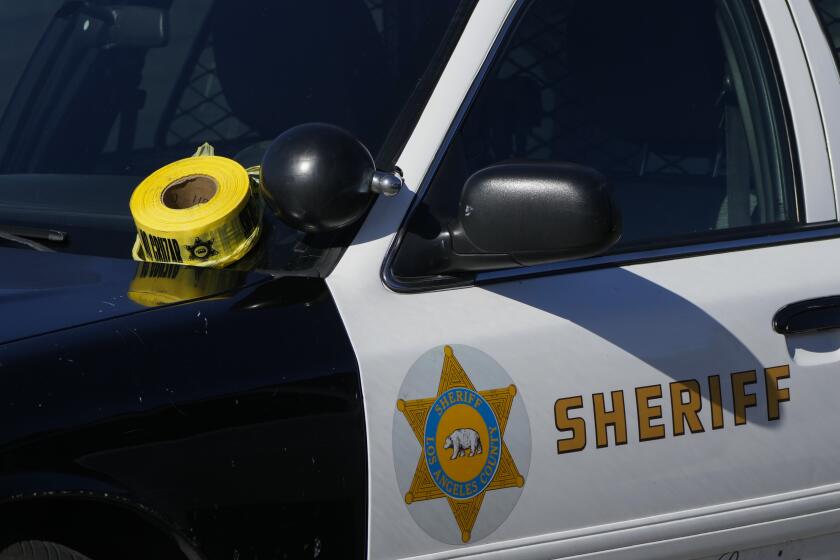The Fight Against Crime: Notes From the Front : Crash Pads for Police Rarely a ‘Suite’ Deal
The “bridal suite” at the Los Angeles Police Department’s Devonshire station is a room kept clean by volunteers. At the Van Nuys Division, no room is available, so a bunk bed crammed into a hallway has to suffice.
“Bridal suite” is cop slang for station house crash pads for officers who live too far away, or work too late, to make morning court appearances or other appointments if they go home for the night. Much overtime and long days are a routine part of the police officer’s lot.
The range of accommodations runs from faux Bonaventure to a bad night at the Bates Motel.
“At some point, every station has had one,” said Lt. John Dunkin, an LAPD spokesman. “I think there’s one here in Parker Center, but I don’t know where it is anymore.”
Most LAPD stations try to have separate rooms for male and female officers, a tough task at stations where space is already at a premium.
The Rampart and West Valley divisions have trailers behind their station.
If a jail cell is empty, male West Valley officers will sometimes sleep behind bars when female officers need to spend the night in the trailer, said Sgt. Dan Carnahan. But Carnahan says he, for one, just doesn’t feel comfortable sleeping in a cell next door to the cell of a man he may have put there.
Newer stations, like Devonshire, usually have nicer rooms because cot rooms were part of the building’s original design.
And in recent years, with all the natural and unnatural disasters that have descended on Los Angeles, cot rooms have gotten more and more use, officers said.
Sgt. Mike Sonntag of the Devonshire station said that just about every night, at least one officer beds down in the four-bunk room there.
Some rooms “get kinda grungy but you’re in a situation where, say you get off at 3 a.m. and you have an 8 a.m. court date. What are you gonna do?” he asked.
The Foothill Division station, currently undergoing major renovations, has a brand new cot room with carpeted floors, separate sleeping areas for male and female officers, air conditioning, a reading light and even a window. The only thing it doesn’t have are beds just yet, but officers are using jail mattresses until they arrive, said Sgt. Tom Smart.
“I have no complaints, you can sleep there,” said Smart, who did just that last week to make an early morning meeting. Sleeping rooms are also a safety measure to spare worn-out officers from long, sleepless drives home, he said.
The Van Nuys station’s bridal suite isn’t actually a room at all, but rather a corner of a basement hallway where a bunk bed has been crammed in, home for the night to any two of 350 officers who work there.
Sgt. Brett Papworth, a Van Nuys watch sergeant, says there are many times when officers need a place to lay their head, but the Van Nuys bridal suite is rarely vacant.
There are plans to expand the cot rooms for both men and women at some stations, newly important because the department is now studying a proposal to change police workweeks to three 12-hour shifts or four 10-hour shifts.
That study is now moving through the department’s chain of command, said the department’s press relations office.
There is no cot room at the North Hollywood station, one of the older Valley stations, said Sgt. Robert Balderrama.
“It would be nice to have a cot room, because there is no place for anyone to go and get any sleep around here,” he said.
Balderrama said North Hollywood officers sometimes sit in their cars all night or go to a 24-hour restaurant and drink coffee to stay awake until a morning court appearance.
At the 77th Street station, the bridal suite is sort of a challenge to the officers’ bravery, to hear them describe it.
They have to share a musty-smelling basement room in a 69-year-old building with a small army of cockroaches, said Sgt. Paul Hernandez.
“I would bet that if you gave the guys a choice of sleeping in a rice paddy or the cot room, they’d sleep in the water,” Hernandez said. “I don’t think anyone goes down there.”
Hernandez describes it as more a “conversation piece” than a practical alternative to a long drive, and Dunkin calls it “about as close to a hovel as you can get.”
But help is on the way: by March, 1994, construction will begin on a new station on the site of the present one.
More to Read
Sign up for Essential California
The most important California stories and recommendations in your inbox every morning.
You may occasionally receive promotional content from the Los Angeles Times.










